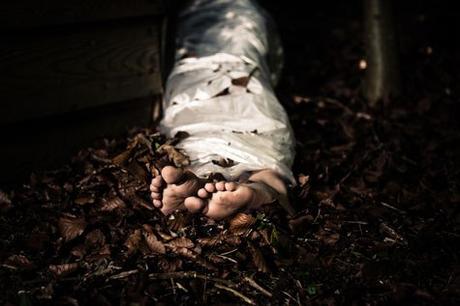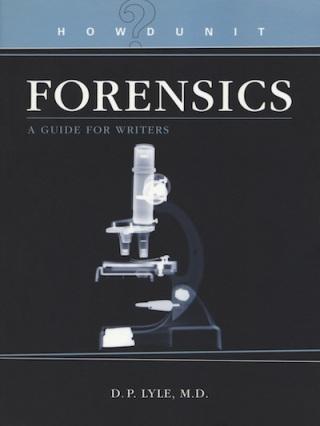
LISTEN: https://soundcloud.com/authorsontheair/episode-31-body-disposal-isnt-easy
PAST SHOWS: http://www.dplylemd.com/criminal-mischief.html
SHOW NOTES: http://www.dplylemd.com/criminal-mischief-notes/31-body-disposal.html

From HOWDUNNIT:FORENSICS:
GETTING RID OF THE BODYSome criminals attempt to destroy corpses, the primary pieces of evidence in homicides. They think that if the police never find the body, they can't be convicted. This isn't true, since convictions have in many cases been obtained when no body is found. And destroying a body is no easy task.
Fire seems to be the favorite tool for this effort. Fortunately, this is essentially never successful. Short of a crematorium, it is nearly impossible to create a fire that burns hot enough or long enough to destroy a human corpse. Cremation uses temperatures of around 1,500oF for two hours or more and still bone fragments and teeth survive. A torched building would rarely reach these temperatures and would not burn for this long. The body inside may be severely charred on the surface, but the inner tissues and internal organs are often very well preserved.
Another favorite is quicklime. Murderers use this because they have seen it in the movies and because they don't typically have degrees in chemistry. If they did, they might think twice about this one. Not that quicklime won't destroy a corpse; it just takes a long time and a lot of the chemical. Most killers who use this method simply dump some on the corpse and bury it, thinking the lime will do its work and nothing will remain. Quicklime is calcium oxide. When it contacts water, as it often does in burial sites, it reacts with the water to make calcium hydroxide, also known as slaked lime. This corrosive material may damage the corpse, but the heat produced from this activity will kill many of the putrefying bacteria and dehydrate the body. This conspires to prevent decay and promote mummification. Thus, the use of quicklime may actually help preserve the body.
Acids are also used in this regard, and once again the criminal hopes the acid will completely dissolve the body. Serial killer Jeffrey Dahmer tried this with little success. Indeed, powerful acids such as hydrochloric acid (HCl), sulfuric acid (H2SO4), and
chlorosulfuric acid (HClSO3) can destroy a corpse, bones and all. If enough acid is used over a sufficient period of time, that is. But this is not only difficult but also extremely hazardous. The acids will indeed destroy the corpse, but they will also "eat" the tub the body is in and chew up the plumbing. Acid fumes will peel the wallpaper and burn the perpetrator's skin, eyes, and lungs.
John George Haigh came to the English public's attention in the 1940s when he confessed to not only multiple murders, but also to drinking his victims' blood and destroying their corpses with acid. He seemed to favor sulfuric acid, which he kept in a vat in his workshop. He took the victims' money and, through forgery, their property and businesses, and then basically laughed at the police as he admitted to the killings, believing they could not prosecute him without a corpse. He was wrong. He was convicted through forensic evidence and was hanged at Wandsworth Prison on August 10, 1949.
So, whether it's Mother Nature or the work of the perpetrator, something almost always remains for the ME and the other forensic scientist to work with. It may be an intact body, a partially destroyed corpse, or a single bone, but it will give them something to use in identification. Let's take a look at how they do this-first with a body and then with only skeletal remains
BODY LOCATIONWith the exception of some photographic comparisons, all these forensic identification techniques require a corpse or skeletal remains. No body, nothing to work with. Often a discovered body is what instigates this identification process. But sometimes, investigators know a homicide has occurred, or has likely occurred, but they can't find the corpse. The Laci Peterson case is an example. When Laci, who was eight months pregnant at the time, went missing on Christmas Eve 2002, in Modesto, California, it was not long before it became obvious that she had been murdered. Authorities launched a search of her neighborhood and the bay where her husband, Scott, had been fishing. In April 2003, the bodies of Laci and her unborn son Conner washed up on shore in San Francisco Bay. Scott Peterson was later convicted of the double murder.
In homicides, finding and examining the corpse is critical. Searchers use a number of low- and high-tech location methods. All evidence is used to narrow the search area, including the victim's work and leisure habits and witness statements. The victim may work several miles from home, so searching along this route would be undertaken. Maybe he frequently ran or walked in a nearby wooded area. Or maybe the suspect's vehicle was spotted or some of the victim's clothing was found in a remote area. These bits of information can greatly focus the search.
One basic rule is to "look downhill" for a burial site. Let's say it is believed that the body in question was buried near a remote roadway. In the area, the terrain rises above the road on one side and falls away on the other. Search downhill. Why? It is much easier to carry a body downhill than up. It's just that simple.
Once the area of search has been defined, a systematic approach to cover- ing the area should be followed. Freshly turned dirt, trenches, elevations or depressions in the terrain may be helpful. Fresh graves tend to be elevated above the surrounding area, while older ones may be depressed. This is due to settling of the soil, decay of the body, and collapse of the skeleton. Interestingly, the depth of the depression is greater if the body is deeply buried. This is likely due to the larger amount of turned dirt, which is subject to a greater degree of settling. Another factor could be that in deeper graves, the increased weight of the dirt over the corpse causes earlier and more complete skeletal collapse.
Tracking dogs, if provided with an article of the victim's clothing, may be able to follow a scent trail to the burial site. Specially trained cadaver dogs search for the scent of decaying flesh. They can often locate bodies in shallow graves or in water. Deeper graves may present problems.

Another important clue may come from changes in the vegetation over the gravesite. The turning of the soil in the digging process and the presence of the body change the soil conditions in the area over the grave. Changes in compaction, moisture, aeration, and temperature may attract plant species that differ from those around the grave. Or, the plants typical for the area may be present but the changed soil conditions may increase the thickness and richness of their growth. This may be visible, particularly from the air.
Aerial reconnaissance and photography can be coupled with thermal imaging. Freshly turned dirt loses heat faster than normally compacted soil; it appears "colder" by such a device. Alternatively, a decaying body releases heat, which may reveal a measurable difference when compared to the surrounding area. So, the thermal images are inspected for either cold or warm spots, and these areas are then subjected to a more aggressive search.
If a suspect area such as a mound or depression is found, special devices that locate sources of heat and nitrogen, both byproducts of the decay process, or that measure changes in the physical properties of the soil, may be employed. Ground-penetrating radar can "see" into the ground and often locate a buried body. Measurement of the electrical conductivity may prove helpful- a buried body often adds moisture to the soil, and the moisture increases the soil's electrical conductivity. Two metal probes are placed in the soil, and an electrical current is passed between them and measured. Changes in this current may indicate where the body is buried.
Magnetic devices may also be employed. A simple metal detector may locate the victim's jewelry or belt buckle.
A special device called a magnetometer, which measures the magnetic properties of soil, can also be helpful. Soil contains small amounts of iron, so it possesses a low level of magnetic reaction. Since the area where the body is buried has proportionally less soil (the corpse takes up space), it will exhibit a lower level of magnetic reactivity. The magnetometer is passed above the soil and locates any areas that have low magnetic reactivity.
Body Encased in Concrete: https://www.breitbart.com/crime/2019/10/17/police-find-missing-womans-body-encased-concrete-arrest-two-suspects/
Body in Concrete in Plastic Storage Container: http://usnews.nbcnews.com/_news/2012/10/13/14409189-murder-victim-found-entombed-in-concrete-was-former-fla-journalist
Acid in Tub: https://www.independent.co.uk/news/world/europe/french-students-dissolve-body-in-acid-after-killing-girl-in-breaking-bad-murder-plot-10447943.html
Body Beneath Another Corpse: https://www.newser.com/story/240700/husband-hid-wifes-body-under-grave-of-wwii-veteran.html
Body Parts in Trash Bags: https://6abc.com/archive/6880388/
Cooked Spouse: https://latimesblogs.latimes.com/lanow/2012/09/la-chef-told-police-he-slow-cooked-his-wife-for-days.html
Laci Petersen in the San Francisco Bay: https://en.wikipedia.org/wiki/Scott_Peterson
Corpse in Freezer in Truck: https://www.latimes.com/archives/la-xpm-1994-07-18-mn-17076-story.html
And
https://murderpedia.org/male.F/f/famalaro-john.htmThe Science of Finding Buried Bodies: http://theconversation.com/the-science-of-finding-buried-bodies-77803
The Science of Finding Dead Bodies: https://www.dailymail.co.uk/sciencetech/article-4515430/Researchers-reveal-track-corpse.html
